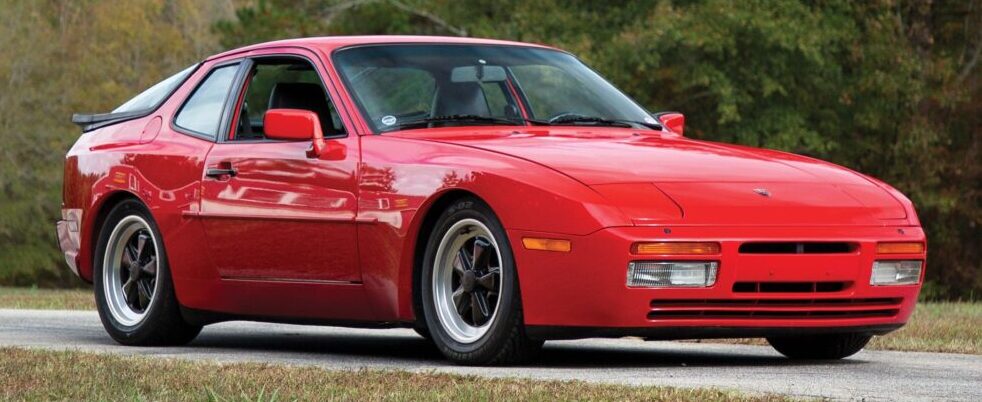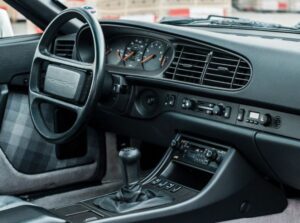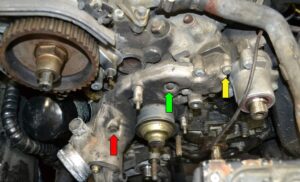The 4 most common Porsche 944 problems
1. Porsche 944 timing belt failure
2. Porsche 944 cruise control problems
3. Porsche 944 DME relay failure
Porsche 944 timing belt failure
The 4 most common Porsche 944 problems. The Porsche 944 is known for its unique front-engine, rear-wheel-drive layout and has gained a reputation as a classic sports car. However, like any vehicle, it has its share of potential issues, and one critical concern is the timing belt failure.
The Porsche 944 utilizes an interference engine design, meaning that if the timing belt fails, there is a risk of the engine’s valves colliding with the pistons. This can result in severe damage to the engine and may lead to costly repairs.
The timing belt is a crucial component responsible for synchronizing the rotation of the crankshaft and camshaft. Proper timing is essential for the precise operation of the engine’s valves and pistons. Over time, the timing belt can wear out, become brittle, or develop cracks, increasing the risk of failure.
To prevent timing belt failure in a Porsche 944, it’s crucial to adhere to the manufacturer’s recommended maintenance schedule. Typically, the timing belt should be replaced at specific mileage intervals, often around 60,000 to 90,000 miles, depending on the model year and engine type.
When replacing the timing belt, it’s advisable to replace related components, such as the tensioner and water pump, to ensure comprehensive maintenance and reduce the risk of future issues. Regular inspections of the timing belt for signs of wear, such as fraying or visible damage, can also help identify potential problems before they escalate.
In summary, the Porsche 944 timing belt failure is a critical issue due to the interference engine design, which can lead to severe engine damage if not addressed promptly. Regular maintenance and timely replacement of the timing belt are crucial to prevent this issue and ensure the longevity of the vehicle.
Porsche 944 cruise control problems
Cruise control issues in a Porsche 944 can be attributed to various factors, and troubleshooting them involves a systematic approach. Here is a detailed explanation of potential problems and solutions related to Porsche 944 cruise control issues:
Check Cruise Control Fuse:
- Start by inspecting the fuse associated with the cruise control system. A blown fuse can disrupt the circuit and prevent the cruise control from functioning.
Verify Vacuum Lines:
- The Porsche 944 cruise control system often relies on a vacuum source. Inspect the vacuum lines for any cracks, leaks, or disconnections. Damaged vacuum lines can lead to a loss of vacuum pressure and affect cruise control operation.
Throttle Cable and Linkage:
- Examine the throttle cable and linkage connected to the cruise control system. Ensure there is no binding, and the components move smoothly. Any resistance or stiffness in these components can impact the system’s ability to maintain a constant speed.
Brake Pedal Switch:
- The cruise control system is designed to disengage when the brake pedal is pressed. Check the brake pedal switch to ensure it is functioning correctly. A faulty switch may prevent the cruise control from engaging or cause it to disengage unexpectedly.
Clutch Pedal Switch (if applicable):
- In models with manual transmissions, there might be a clutch pedal switch that disengages the cruise control when the clutch is pressed. Verify the functionality of this switch.
Speed Sensor and Wiring:
- The cruise control system relies on speed sensor input to maintain a constant speed. Inspect the speed sensor and its wiring for any damage or loose connections. A malfunctioning speed sensor can lead to erratic cruise control behavior.
Control Module and Actuators:
- The cruise control system includes a control module and actuators. Check for any fault codes in the system, and if possible, use diagnostic tools to assess the health of these electronic components.
Throttle Position Sensor (TPS):
- The TPS plays a crucial role in cruise control functionality. If the TPS is malfunctioning, it can affect the system’s ability to regulate speed accurately.
Professional Diagnosis:
- If the above steps do not resolve the issue, it’s advisable to seek professional assistance. A qualified mechanic with experience in Porsche vehicles can perform in-depth diagnostics using specialized tools to identify and address cruise control problems.
By systematically addressing these potential issues, you can enhance the chances of identifying and resolving cruise control problems in a Porsche 944.
Porsche 944 DME relay failure
The DME (Digital Motor Electronics) relay failure in a Porsche 944 can lead to various engine-related issues, as the DME relay plays a crucial role in supplying power to the engine control module. Here’s a detailed explanation of the problem:
Function of the DME Relay:
- The DME relay is responsible for providing power to the Digital Motor Electronics control unit, which manages essential engine functions such as fuel injection, ignition timing, and idle speed control. It essentially acts as a switch that allows or interrupts power flow to the DME.
Symptoms of DME Relay Failure:
- Common symptoms of a failing DME relay include intermittent starting problems, engine stalling, or complete engine shutdown. The relay might exhibit signs of overheating, and the issues may occur sporadically.
Location of the DME Relay:
- In the Porsche 944, the DME relay is typically located in the fuse box or relay panel near the car’s battery. It’s a good practice to consult the vehicle’s manual or diagrams to precisely identify the DME relay location.
Visual Inspection:
- Start by visually inspecting the DME relay for any signs of damage, overheating, or corrosion. Check the relay’s connections and wiring for integrity. Burnt or discolored contacts on the relay may indicate a problem.
Relay Replacement:
- If the DME relay is found to be faulty, it is recommended to replace it with a new, high-quality relay. Genuine or OEM (Original Equipment Manufacturer) relays are preferable to ensure compatibility and reliability.
If the diagnosis and replacement prove challenging, or if the issue persists after relay replacement, seeking professional assistance from a qualified Porsche technician or an auto-electrician is advisable. They can perform advanced diagnostics and address any underlying electrical issues.
Water pump failure
Water pump failure is a critical issue in a vehicle’s cooling system that can lead to serious engine damage if not addressed promptly. Here’s a detailed explanation:
Symptoms of Water Pump Failure:
- Common signs of a failing water pump include coolant leaks, a visible or audible wobbling noise from the pump, overheating, and steam coming from the engine compartment. A damaged water pump may also result in a noticeable reduction in coolant circulation.
Causes of Water Pump Failure:
- Water pump failure can occur due to various reasons, including worn bearings, a damaged impeller, seal leaks, or a broken drive belt. Over time, the pump’s components may wear out, leading to decreased efficiency and eventual failure.
Overheating:
- A malfunctioning water pump can result in inadequate coolant circulation, leading to engine overheating. If the engine temperature gauge indicates higher-than-normal readings or if the vehicle’s warning light illuminates, it’s crucial to address the issue promptly to prevent engine damage.
Coolant System Pressure Test:
- A pressure test of the cooling system can help identify leaks and assess the overall integrity of the water pump and other components. This test is typically performed by a mechanic using specialized equipment.
Replacement of the Water Pump:
- If water pump failure is confirmed, it is essential to replace the pump promptly. Replacement involves draining the coolant, removing the old pump, installing a new one, and refilling the system with fresh coolant.
Preventive Maintenance:
- Regular coolant system maintenance, including scheduled coolant changes and inspection of the water pump, can help prevent premature failure. Addressing any signs of wear or leaks promptly can extend the life of the water pump and the overall cooling system.
Are you already a proud owner of a Porsche 944? If so, check out our selection of parts for this car at the following link:
https://octoclassic.com/product-category/porsche/944
Photos sources: voiturebonoccasion, Pelican Parts, pinterest.de










